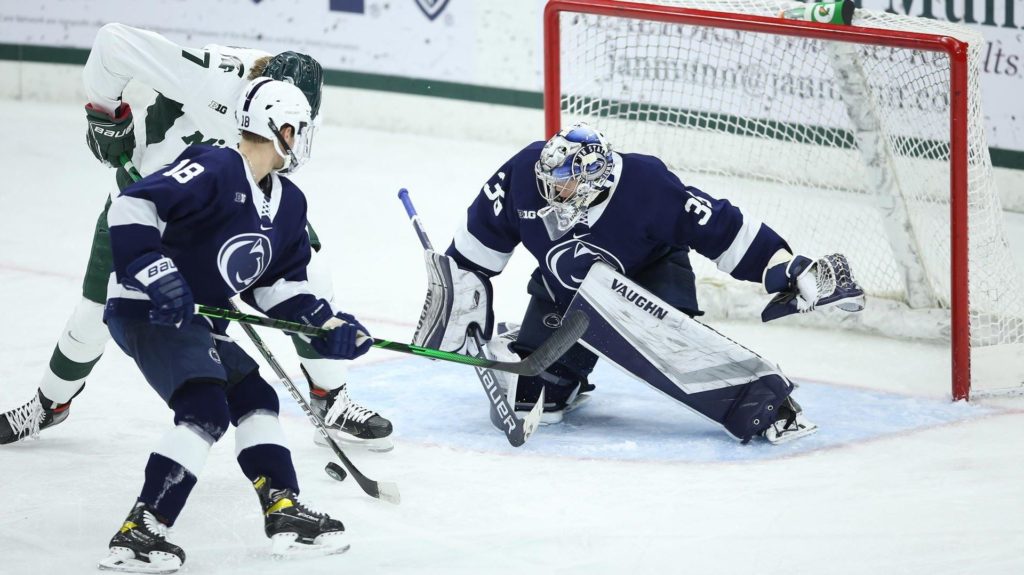
Each week during the season, we look at the big events and big games around Division I men’s college hockey in Tuesday Morning Quarterback.
Paula: This week I’m joined by Dan Rubin, Atlantic Hockey columnist, while Jimmy Connelly is otherwise occupied. Dan, it’s a pleasure to talk hockey with you. Happy New Year!
It’s unusual to have so much to discuss at the start of January, but as you noted in this week’s Monday 10, the first post-break play saw league play in all six conferences for the first time this season, and college hockey fans were treated to some great matches.
There were the split Denver-Colorado College and Minnesota Duluth-St. Cloud State series. There were the two series in the ECAC that each produced a tie game. There was Penn State’s uncharacteristic 1-0 win over Michigan State Sunday – and it should be noted that we’re writing this column before Monday’s rematch between the Nittany Lions and Spartans has been played (editor’s note: Michigan State won 5-1) – and impressive sweeps by Bowling Green in the WCHA and Robert Morris in the AHA.
Given the overall pandemic-related lunacy of 2020 and how it affected every aspect of life as we know it, this start of post-holiday hockey feels almost like normalcy to me.
Collectively, Dan, what did this weekend of college hockey say to you? Given the shortness of the first “half” of the season, what are we seeing here as 2021 begins?
Dan: First, thanks for having me back as I attempt to fill Jimmy’s shoes as admirably as humanly possible.
This weekend in college hockey felt like the true start of the season, and I can’t agree with you more about the post-holiday rush of conference college hockey. January always feels like the real start of the season, and it always represents the moment where league races heat up for teams looking to jockey for home series. Every matchup has some form of postseason implication, and the non-league games start to filter away with the end of holiday tournaments. We obviously didn’t get the holiday tournaments as usual, but the start of 2021 at least made us feel like college hockey was, indeed, back.
The competitiveness on the ice really drove that point home, and I think this past weekend emphasized how competitive these next two months are going to be. These teams know each other so well but use the first half to form identities. Those identities are now rounding into form in time to formulate the right brand of rivalry on the ice.
In the NCHC, for example, the Duluth-St. Cloud series produced the front runner for game of the year with the overtime winner by the Bulldogs on Saturday, but the Huskies rallied to win three points on Sunday. If that’s an indication of how things are going to turn out, I couldn’t be more excited, especially because these teams are going to beat on one another for the next eight to ten weeks or so.
That last point is my real detail on everything. These teams are going to see each other A LOT before the playoffs begin, and I think there’s an interesting opportunity for teams to really earn new looks from the national perspective. We all know Minnesota, Boston College, North Dakota, UMD, and Minnesota State are going to own top headlines, but are there other teams that you’re really looking forward to maybe catch some teams off guard?
Paula: Given that the majority of play will be conference hockey, I’m not sure that many teams will have the opportunity to catch anyone they play off guard between now and the end of the regular season, but fans may become more aware of teams that don’t usually get a lot of national discussion. As you say, there are opportunities to expand our conversation to include teams from leagues that don’t get a lot of attention nationally, like the WCHA and AHA.
Bowling Green is a team that will be impossible to ignore as the season progresses. The Falcons are averaging more than four goals per game and have the best scoring margin in D-1 hockey, fueled in part by the goaltending tandem of sophomore Zack Rose and senior Eric Dop.
I look at how well rounded Robert Morris is this year and can envision another close, exciting end to the Atlantic Hockey regular season, with AIC and an improved RIT in the mix. Then there’s Omaha’s start. In arguably the toughest conference in D-I men’s play, the Mavericks add an interesting wrinkle to the top of that conference, too.
Because of the nature of the season – as you mention – we’ll all be looking at the national picture differently, and that necessarily lends itself to conversations about the merits of teams and leagues that usually don’t dominate discussions. Jimmy and I have had some fun this season speculating about how the NCAA selection committee will determine the national field come March. Dan, what possibilities do you see for this year’s national tournament? What would you like to see the committee do?
Dan: This year’s tournament? I would recommend buckling up for this portion of the segment because I’m about to press the red button…
Let’s start with tournament criteria. Ed Trefzger and I talked about NCHC commissioner Josh Fenton’s idea to weigh previous years’ performance into the allotment for this year’s bracket. He admitted it’s not a perfect system, but I like his take on it. A similar system exists in European association football (okay, fine, soccer) for “club coefficients” related to their elite championship competitions. All slots are balanced against a calculation involving the national team’s performance and the collective performance of both the clubs and the leagues. Leagues are automatically granted status based upon their performances at an elite level, but they might receive more exalted status with byes through to certain rounds based on the number of times clubs advance beyond a certain round. The mathematical coefficient determines the number of slots and where those leagues enter international competition.
I’m not saying that the system is perfect, but weighted averages and coefficients tend to skew correctly based on previous years’ performances.
In my mind, leagues like NCHC and Hockey East should want to weigh previous years because of their successful stretches. I actually appreciate that more than most and touched on the NCHC’s national profile in an interview with Mr. Fenton at Minnesota-Duluth’s national championship win in Buffalo in 2019. I actually agree more than I’m about to sound like I do because there’s a reason those teams are annually in the Frozen Four conversation.
I just think an unorthodox year befits an unorthodox practice. I really liked your idea with Jimmy to hand two slots to every league because Atlantic Hockey clearly benefits from that methodology (and I’m an unabashed AHA person), but I know it would raise more than a few eyebrows. That said, I love that this year is opening opportunities for schools like AIC and Robert Morris, both of which ranked in the national polls this week. I think more people are finding out about those teams before the inevitable first round national upset, and I think they’re seeing that the caliber and parity in college hockey is getting stronger.
That’s why Bowling Green is rocketing up the national polls without a win over Minnesota-Duluth or Michigan or Minnesota or even Minnesota State; people are learning how good the teams really are because the spots originally occupied by teams like Union, Harvard or Cornell are open season. Call it a silver lining of a really complex, nuanced situation for ECAC.
I just think about football’s issue this year when the Big Ten and Pac-12 opted out of the early season. Those teams weren’t considered for national polls for a couple of weeks, and a couple of teams that hadn’t been ranked in decades slid into the larger conversation. It opened the door for teams like Coastal Carolina and Louisiana-Lafayette to enter the conversation early, at which point more voters were able to watch them because of their new, national profile. It nearly vaulted Cincinnati and Brigham Young into the national championship conversation.
So that leads me back to the coefficient. I’m not saying leagues like Atlantic Hockey or the WCHA should receive four berths in the national tournament, but I think there’s a really creative way to hand out slots. I think this year, more than ever, is a great chance to strike the strange iron while it’s hot.
This is so unorthodox and so unconventional, and I think that means we have to remain as open minded as I think our commissioners, coaches, players, writers, staff members, dreamers and fans are trying to remain. I wouldn’t hate expanding the postseason for one time to enable play-in games if that’s a safe option. It’s a great discussion, and I think we’ll ultimately find a balance between the weighted average and the eye test. I’m open to an exhaustively researched PowerPoint presentation on this if the committee so desires.
I’ll turn this back to you to digest all of this.
Paula: I’m glad you mention play-in games because that is something I’ve been thinking quite a bit about since last week.
If expanding the tournament is an option and can be done safely, I think having play-in games based on the model you mention would be an interesting – and perhaps equitable – way to approach the selection. I doubt, though, that the NCAA would consider this.
You talk about the unorthodox nature of this season, and I think it’s because of all the strangeness that I remain adamant about the two autobids for each league. That is another thing that I doubt that the NCAA will consider.
Between now and March, there is a lot of hockey to be played – a lot more than usual, in some cases. Two weeks ago, Jimmy asked me about the matches I was looking forward to during the rest of the season, and now I’m putting that question to you: Dan, as you anticipate the remainder of the season – especially the AHA schedule – which games and series are you most looking forward to?
Dan: I’m going to miss not seeing certain teams this year, namely RIT in the annual USCHO Derby, but I’m very excited out here to witness what happens when these teams play each other frequently over two months’ time.
Atlantic Hockey feels like the old Original Six NHL, and the games are going to gain some quick intensity over the next couple of weeks. Army West Point is playing American International on three consecutive nights this week, and AIC is scheduled to go from that series right into a series against Bentley and Sacred Heart over the two weeks after it. Those games are going to be real battles, and the pressure to win is even stronger given the league’s postseason emphasis on percentage of possible points played.
This whole setup should be great if the teams continue to rise up against one another. RMU is a warhorse team, but Canisius is a pleasant surprise. Mercyhurst is definitively improved and just picked up three transfers from Alaska Anchorage, and RIT is a solid team flying under the radar. Throw in the Air Force component, and things will get chaotic pretty quick.
Beyond that, I’m always excited to see what Hockey East and ECAC can throw at us out here. ECAC’s four teams are going to play a ton of games against one another, and Quinnipiac’s travel schedule is going to draw multiple games on multiple nights against good teams. I mentioned on this week’s podcast with Ed that the travel could be tough to navigate, but even a tiring Bobcat team will draw some pointed shots from the other three teams. I like St. Lawrence a lot this year, specifically.
It’s going to be a fun ride built with chaos and unpredictability. That’s how college hockey is trending, and I’m going to enjoy every second. Paramount to all of that is, of course, the safety of everyone involved, especially in the midst of an unrelenting, surging pandemic, but I’m still excited for these players and the coaches – all of whom are laying it on the line every day for their teams and universities. 2021 is going to be something we never forget.


